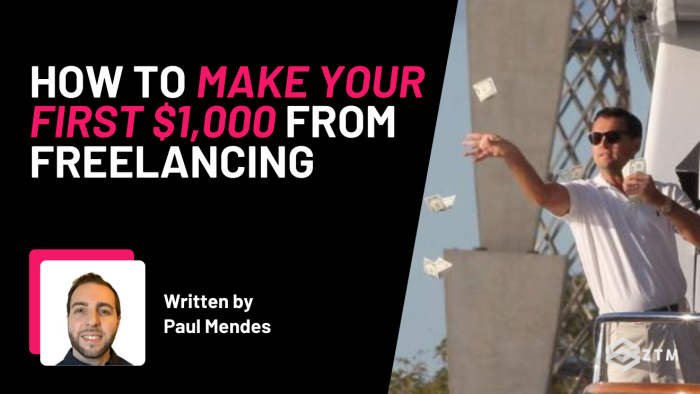Freelancing is great in that you can take a skill that you already have, and earn some easy extra cash.
For example
Maybe you can write code, and a friend of a friend needs a website, and suddenly you’ve made a few hundred bucks for some easy work.

You do that a few more times and you suddenly realize that if you could get more consistent website clients (or any freelance project), then you could easily double or triple what you’re earning now, all while possibly working fewer hours.
It sounds good right, but how do you make that happen?
Well, in this guide, I’m going to walk you through 7 steps to hitting that first major milestone that all freelancers aim for, aka “How to make my first $1,000 freelancing”
Fun fact? These exact same steps can then be followed and repeated to hit your first $10k a month or more in sales. (It’s literally the exact same steps that I followed to do just this!)
It’s not hard either. You just need a process, so let’s show you mine…
Sidenote: Don’t fancy reading, or simply want a more detailed explanation, with additional information and advice? Well then, go and check out my complete guide to freelancing course.
This Freelancing Bootcamp Course gives you the step-by-step guide to go from ZERO EXPERIENCE to becoming a Freelancer and having a profitable freelance business getting clients you never thought possible.
Anyway, with that out of the way, let’s get into this guide.
Step 1. Lay the Freelancing foundation
Obviously, in order to make money as a freelancer, you need some kind of skill or service to offer.
If you’re not sure what to offer, start by looking at your current skills, strengths, and what you enjoy doing that other people would pay for.
For example
If you already work in tech and can code, then you could potentially build websites, apps, plugins, and more, and people will happily pay for it.
Heck, some people will even pay recurring support fees or access after that initial sale also. It doesn’t need to be anything groundbreaking, it just needs to be something easier than they can do for themselves.
Editor’s note: I once saw someone who built a plugin that would connect a forum tool and a payment provider for single-sign on (SSO API). The forum didn’t offer this and still doesn't, 8 years later.
The freelancer started out by offering this forum to payment provider connection as a done-for-you service that took them less than an hour to complete. Later they implemented a plugin version and sold literally thousands of units at $300+ per year.
The key point here is that you probably have skills you’re overlooking, so you need to make a list.
Jump onto Upwork and see what services people are offering that you could offer also.
- What could you do easily?
- What could pay well?
- What do you enjoy?
- What has high demand?
The website build example is great because 1,000’s of people per month are looking for this service in some shape or form.

Some will even pay tens of thousands of dollars for a custom-built design to their specifications.
This is a good thing to take into consideration, because if you want to scale to $1-10k a month, you need to make sure that you have that potential.
Not just in terms of potential market of customers, but:
- How many of X would you need to do to hit that target?
- Also, how long does X take and could you fit that volume into a month?
We’ll cover pricing more in a second but it’s good to be thinking of this now as you decide on your service to offer. Can that service make the money you want in the time frame you have?
For example
If we go back to the site build example, if you’re only asking for $150 for a site and it takes 3-4 hours, (assuming you're just customizing a pre-built theme) then to make your first $1k, it would take:
$1,000/150 = 6.67 or 7 websites total.
At 4 hours each, you would be looking at 28 hours to hit your goal.
Not bad right!?
But, if you wanted to scale that out to $10k a month, you would now need to be making 67 websites a month, at 268 hours a month.
Still a good hourly rate, and it can scale, but again, worth thinking about in advance, and we’ll cover it more later.
For now though, you need to be able to sell those services.
Step 2. Automate some of your sales process
One of the biggest problems that new freelancers face, is a lack of structure in terms of:
- Marketing
- Sales, and
- Systems (more on systems in a second).
Solving the marketing issue
What you don’t realize when you first start out is that you not only have to provide the service, but you also have to attract and sell clients.
You can do this with a website of your own (which I recommend), but in the meantime, you can also join sites like Upwork. The reason being is they have literally tens of thousands of visitors a day, who are actively searching to hire someone for something.
This means easy traffic from a very warm audience (ie they want to buy).
Solving the sales issue
The next step is helping to sell them on you as the best option, without you having to email back and forth a bunch of times or wait for a referral from a friend.
The easiest way to do this is to create a portfolio, so that people can see you and what you offer, and then see examples of your work and pricing.
It’s really easy to do also:
- Start off by creating an account on a freelancing platform such as Upwork
- Add information like your name, location, and education
- After that, upload various work samples that showcase your best skills. These ‘case study’ examples can be from prior job experiences, even if it was at your nine-to-five, or work for friends and family
Then, simply continue adding to your profile until you feel it’s a well-rounded showcase of your abilities.

The more information you add to complete your profile, the more likely a client will be interested in your page.
The next thing is to add your pricing on there, but let’s look at this a little first before deciding what to charge…
Step 3. Set your rates
We’ve already talked about the simple math on your offer, and how we can use this to hit your $1,000-$10,000 goals.
However, we can’t just pull a number out of the air to set as our price - at least not at first. This is why I recommend you do some market research on what you want to offer, and see what the current rates other freelancers charge and where you should set your rates.
The reason is that unless you already have an impressive portfolio of work, you don’t want to charge too high a rate when you start because that may discourage some clients from working with you.
So:
- Look at the lower rates and see if they will fit into your $1k and desired hours goal
- Would they work?
- How does it alter when you raise it by 10-20%?
Use this as a rough guideline for your goal.
You want it to be:
- High enough that you can hit your desired cash flow and hours worked goal
- Low enough to match your current portfolio
- But not so low that you have to deal with tire kickers all the time
For example
If we go back to Upwork and look at website builds, we can see that prices vary from a starting price of $99 for some freelancers, while others charge a $1,000 starting rate that rises as the customer requests more features.

Obviously, what you can charge is going to vary based on your experience and what you feel comfortable with, against what the market is willing to pay.
For example
Let’s assume that you’re just starting out and building your portfolio, and you only have 2 or 3 sites built to showcase.
You could do a few things here. You could either:
- Do some free sites for friends and get some initial reviews and more projects on your portfolio
- Start offering cheaper sites builds to build your portfolio and bring in cash
- Or build some sites for yourself to showcase your full range of skills, and then raise your costs above the average
We never want to start at the lowest offer, unless we need immediate cash.
Also, be sure to understand that the “price myth” is a real phenomenon and that clients ARE willing to pay more than the cheapest available rate to get their job filled by the best candidate. That’s why the freelancer above has built 174 sites at $1,000+ each.
Figure out what you’re comfortable with charging, based on your research and your goals and criteria, and then add that to your portfolio.
Then, let’s look at another way to make you more money…
Step 4. Be the specialist
Although you have set skills and can offer a wide range of services, you’ll make more money by offering less.
The reason being, is that you can both show that you’re a niche specialist in a topic, while also building out systems to follow for every time you provide the service. This means you can cut out any extra time sinks, errors, or costs, and even outsource some of the work.
For example
If you niched down to only building e-commerce stores on Shopify, you could charge even more, as you’re now a specialist.
Solving the systems issue
And then, because you’re always working on Shopify, you can set up systems for:
- The initial delivery of project information
- Requesting files
- Setting up the design
- Building the site
- Design change requests
- Delivering the finished product
- Etc
Not only will this make it much easier for you, but also greatly improve the speed of your process, and reduce any additional mental bandwidth.
Suddenly your builds go from a week-long project to a single day, and you can now bring on more customers, and make more money in less time.

TL;DR
Create a system for anything you repeat more than 5x - regardless of what projects you offer, or even if you choose to specialize.
Step 5. Outbound vs Inbound
Thanks to the large volume of traffic that visits Upwork and other sites, you could in theory just sit back and wait for people to purchase from you (inbound marketing), or, you can actively go out and pitch your services (outbound marketing).
However, rather than diving into the multiple steps of client research and outbound marketing, you can start with some easy semi-outbound methods, and just use Upwork instead.
What do I mean?
Well, some customers on Upwork will actually post job requests instead of just purchasing a set service. Normally this is because they have some additional specifics that they want to meet that are not in the average service offering of most people.
Better still? You can even be fairly lazy with this method.
How? Well, if you have a freelance account on Upwork, then the website automatically suggests jobs you might like when you sign in to the home page!

It takes the skills you’ve listed in your profile and matches them with jobs that it thinks you might be interested in applying for. Sure, you have to check them out and apply, but it means you don’t have to scan all the job postings each day either!
You can also search for jobs manually by typing into the search bar and exploring all the jobs that are constantly being posted to the platform - which is what I recommend if you really want to scale…
Step 6. Systemize your applications
Here’s the thing - applying for jobs (even on a site with warm leads like Upwork) is not a 100% success rate.
This means that if you want to secure new projects, then you need to be applying daily, and multiple times, to make sure you get them.
An easy way to do this, is to set up a routine for outreach - even on days where you already have client work coming in. This way, you always have a pipeline of new clients and no dead zones where you have no work or funds coming in.
My recommendation is to spend 1 hour per day searching for freelance jobs and another 1-2 hours creating proposals to send to those jobs. (Assuming there’s a few to apply to).
Why so long spending applying? Simply because people want to hire the best solution for them and their needs. It’s not always about the lowest price, but finding the right person for the job.
Since creating winning proposals is how you ultimately make money as a freelancer, a large majority of your time should be spent on this step.
Make the effort to stand out
For every proposal you send out, make sure that you’re writing a unique cover letter, answering all the clients' questions in their project brief, and most importantly, doing whatever you can to stand out from the competition.
You want to ensure that your profile and proposals are not a cookie-cutter, cut-and-paste copy that the client has probably seen before also.
Use this as an opportunity to be original and to highlight your skills in a unique way. Letting your personality shine through and staying consistent will help you get the momentum going, even as a complete freelancing newbie.
Repeat steps 2-4 for as long as needed until you start hearing back from clients.
Once a client has shown interest in a proposal you sent, it’s then time to get the client on a zoom call for an interview with you…
Step 7. Land jobs, deliver quality work, and repeat
The purpose of any interview is to see if the 2 parties at hand are a good match for each other before moving forward.
So have a list of questions ready to ask the potential client once they are done asking you all of their questions.
This is called “qualifying clients” and will ensure that you only take on projects that you can deliver quality work for, because at the end of the day, your entire goal is to get 5-star reviews and testimonials from every job you work on.
Please don’t overlook this part because if you do, it can cause immense damage to your profile and job success score. On the other hand, if you start by landing small entry-level projects and going above and beyond, you can be on your way to earning your first $1,000 freelancing quicker than you could have imagined!
In the video below, I go over my own personal journey of how I made my first ten thousand dollars online by freelancing on Upwork.
Time to go make that money!
Freelancing is a thriving industry that offers the potential for great success among independent workers along with dozens of other benefits that remote-work provides.
However, when you are just starting out, it can be difficult to get momentum going in your freelancing career. You may not have much experience and not know if freelancing can actually be a profitable choice for you.
Stay strong and don’t get discouraged in the beginning, as things can have a slow start. Follow these steps to ensure that you stand out above the rest, and before you know it you will be on your way to earning your first $1K as a freelancer as well.
And remember: If you want a more detailed explanation on this entire process, with additional information and advice from someone who freelances for a living, check out my complete guide to freelancing course.
It will give you the step-by-step guide to go from ZERO EXPERIENCE to becoming a Freelancer and having a profitable freelance business getting clients you never thought possible.








